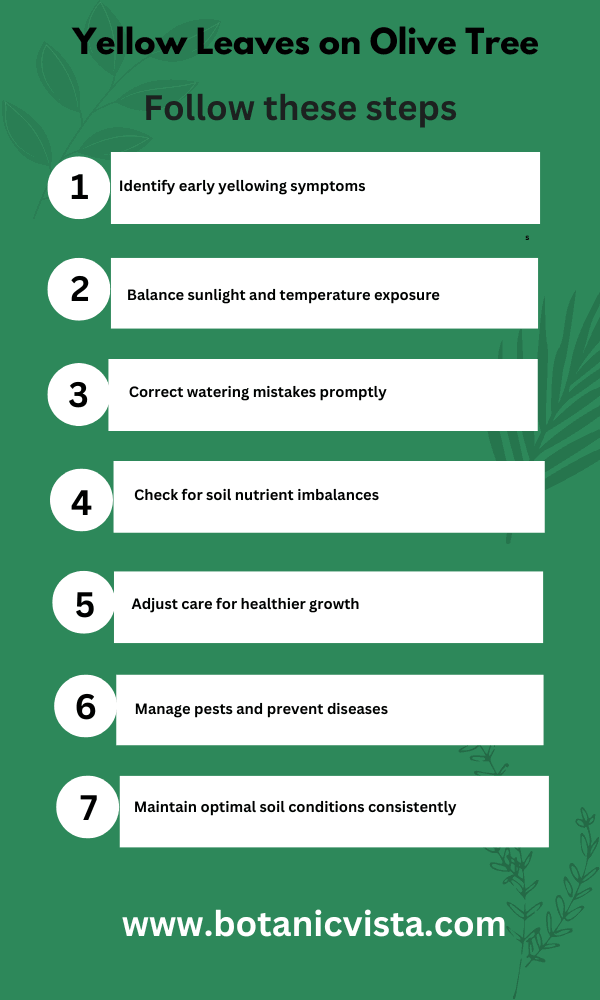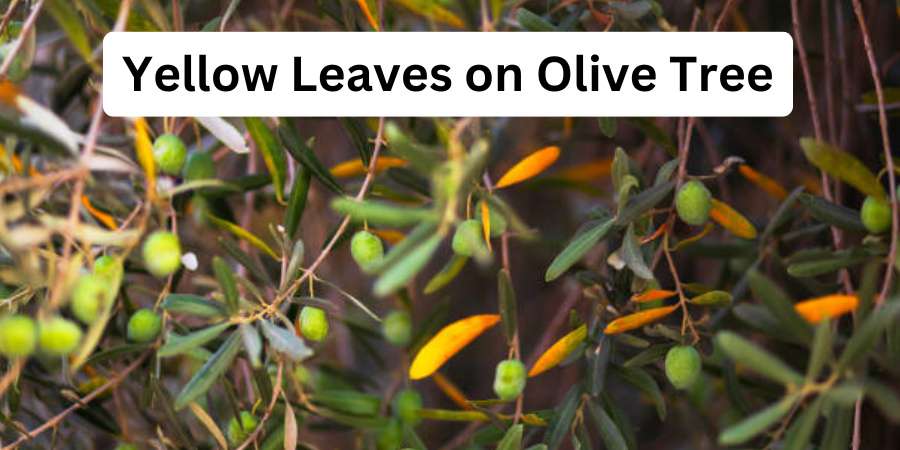Last Updated on October 14, 2024 by Jocelyn
Olive trees are drought-resistant and hardy in the Mediterranean region. However, seeing yellow leaves on your olive tree can be alarming. These trees need patience and proper maintenance to avoid yellowing. But, with the right horticulture techniques, they can stay healthy and thriving.
In the summer, especially, potted olive trees need careful watering. Overwatering causes yellow leaves. On the other hand, under-watering may stunt growth. Therefore, regular pruning of branches helps maintain their elegant shape and encourages blooming.
In the Mediterranean Basin, olive trees are traditionally cultivated for their fruits. These trees add an ornamental touch to gardens. Moreover, they produce olives used in table olives and olive oil. Proper care keeps their vibrancy and supports ripening.
In this article, we’ll explore the symptoms, causes, solutions, and preventive measures for yellow leaves on olive trees!

Table of Contents
ToggleIdentifying the Symptoms
When your olive tree’s leaves start turning yellow, it’s giving you important clues about its health. Those yellow patches and dark spots are signs that something isn’t quite right.
But don’t worry! Noticing these early warnings is the first step toward keeping your tree vibrant and thriving. By observing these symptoms closely, you can quickly address any issues and help your tree stay healthy.
| Symptom | Description |
| Yellowing Leaves | Gray areas on leaves, are a sign of fungal infection or overwatering. |
| Chlorotic Areas | Pale sections on leaves, usually from inadequate light or nutrient deficiency. |
| Necrotized Spots | Dark, dead patches on leaves, caused by disease or root issues. |
| Gray-leaf Spots | Gray areas on leaves are a sign of fungal infection or overwatering. |
| Phylloptosis | Early loss of leaves due to severe stress or environmental factors. |
| Curling with Yellow Hue | Leaves curl while turning yellow, possibly due to poor soil conditions or light deficiency. |
| Drooping Leaves | Drooping leaves, indicating poor drainage or root rot. |
| Dry, Brown Edges | Leaves develop dry, brown tips, often due to extended dry periods or salt build-up in the soil. |
Root Causes of Yellow Leaves on Olive Trees
These issues commonly arise from extremes in sunlight and temperature, incorrect watering practices, or imbalances in soil nutrients. Identifying these root causes is key to maintaining the health of your olive tree.
Let’s explore each factor in detail.
1. Sunlight and Temperature Extremes
Olive trees love sunlight, but too much or too little can cause yellow leaves. If the tree gets too much sun, the leaves might dry out and turn yellow. On the other hand, cold temperatures can stress the tree, leading to similar symptoms.
I once noticed my olive tree’s leaves turning yellow after a sudden drop in temperature, so I moved it to a warmer spot, and the leaves gradually recovered.
2. Watering Mistakes: Too Much or Too Little
Watering can be tricky with olive trees. Too much water can drown the roots, causing the leaves to turn yellow and fall off. If you don’t water enough, the tree can become stressed, and the leaves may be yellow as well.
It’s important to find the right balance, especially during hot months when the tree needs more water. I’ve learned that watering deeply but infrequently keeps the soil just moist enough.
3. Soil Nutrient Imbalances
Soil health is crucial for olive trees. A lack of key nutrients can lead to yellowing leaves, each deficiency showing different symptoms.
4. Nitrogen Deficiency: Pale, Yellow Leaves
Nitrogen is essential for the green color of leaves. If your olive tree is lacking nitrogen, the leaves will become pale and yellow all over. Adding a balanced fertilizer helped my tree regain its vibrant green color.
5. Potassium Deficiency: Tips Browning
When the edges and tips of the leaves start to brown and curl, it might be due to a potassium deficiency. This nutrient helps the tree manage water and resist diseases. I noticed this on my tree and adjusted the potassium levels in the soil, which helped the leaves recover.
6. Magnesium Deficiency: Yellowing Between Veins
If the leaves of your olive tree are turning yellow between the veins while the veins remain green, it could be a sign of magnesium deficiency. This issue often shows up in older leaves first. I’ve found that adding Epsom salts to the soil can correct this problem over time.
7. Iron Deficiency: Young Leaves Turning Yellow
Iron is vital for new growth. If young leaves are turning yellow while the older leaves stay green, it’s likely an iron deficiency. This problem usually occurs in soil with a high pH. I addressed this by using a soil acidifier, which made the nutrients more available to the tree.
Effective Solutions for Yellowing Leaves
Have you noticed your olive tree looking a bit dull with yellowing leaves? Don’t worry, it’s easier to bring back that lush, green look than you might think. With just a few simple steps, your tree can thrive and brighten up your space again.
Let’s dive into some easy, effective solutions to help your olive tree stay healthy and thriving all year round.
1. Boosting Nutrient Intake
Yellow leaves often mean your olive tree isn’t getting enough nutrients. You can help by giving your tree a nutrient-rich fertilizer. Fertilize your tree 2-3 times during spring and summer by mixing 100-150 grams of potassium and 200-300 grams of boron with water.
This will help the tree regain its green leaves and stay healthy.
2. Perfecting Water and Soil Balance
Olive trees need just the right amount of water. If you water too much, the roots might rot. If you water too little, the tree could dry out. Make sure your tree is planted in well-drained soil and that the water doesn’t sit at the bottom of the pot.
Avoid waterlogged conditions by placing pebbles at the bottom. This way, your tree’s roots can breathe, and the leaves stay green.
3. Controlling Temperature and Sunlight
Olive trees thrive best in warm conditions with plenty of sunlight. If the temperature drops below -10°C (14°F), the leaves may start to drop. Ensure your tree is in a spot where it gets plenty of bright, direct sunlight.
If you’re growing the tree indoors, place it near a window that gets plenty of natural light. This will keep the leaves from turning yellow and help the tree grow strong.
4. Shielding from Pests and Diseases
Fungal infections and pests like aphids and spider mites can cause yellow leaves too. Use neem oil as a natural repellent to protect your olive tree. Misting your tree with a diluted insect spray can also help keep bugs away. This keeps your foliage looking good and free from harmful pests.
5. Maintaining Optimal Conditions
Finally, don’t forget to fertilize your tree with organic matter. This keeps the soil balanced and nutrient-rich. Spread mulch around the tree to maintain moisture and improve the growth of the roots. A healthy tree means bright, green leaves.
Read more to find effective solutions for common plant problems:
- Fungal Leaf Spot Monstera
- Peace Lily Flower Turning Black
- Snake Plant Root Rot
- How to Fix Monster Brown Leaves
Preventive Measures
Olive trees are known for their strong leaves, but sometimes, they might turn yellow. It’s important to notice these changes early to keep your tree healthy. I’ve had my own olive tree, and I found a few simple steps that helped prevent these yellow leaves.
| Preventive Measure | What to Do | Why It’s Important |
| Watering | Maintain proper moisture levels | Prevents leaf discoloration due to improper watering |
| Sunlight and Shade | Balance sunlight exposure with some shade | Protects the tree from leaf damage caused by overexposure |
| Nutrient-Rich Soil | Use a balanced fertilizer | Ensures the tree receives essential nutrients to stay healthy |
| Regular Checkups | Inspect leaves and soil weekly | Helps catch and address potential issues early on |
FAQ’s
Q: Do Olive Trees Need Direct Sunlight?
A: Yes, olive trees need direct sunlight to survive. They grow best in a spacious spot with full sun for at least six to eight hours a day. Positioning the tree near a south-facing or east window in a bright, dry room helps it stay healthy.
Q: What is the Lifespan of an Olive Tree?
A: An olive tree can live for over 500 years. Some of the oldest trees are even 1500 years old. Humans grow them for oil and fruits like brined olives. These trees are loved and known to bear fresh fruits for many years.
Q: Do Olive Trees Drink a Lot of Water?
A: Olive trees are quite resilient. They don’t need a lot of water and can survive with almost zero precipitation in dry geographic areas like California. In Sonoma, they may drop leaves in October if the amount of water is low, but they adjust their demands based on seasonal changes.
Q: What Does an Overwatered Olive Tree Look Like?
A: Yellow leaves, falling leaves, and wet soil are signs your olive tree is overwatered. The leaves may curl or turn brown at the base of the tree due to poor drainage.
Q: What Do You Do When Olive Tree Leaves Turn Yellow?
A: Ensure your olive tree receives regular feeding to prevent yellow leaves from nutrient deficiency. Proper watering helps keep the leaves vibrant green and the tree healthy.
Conclusion
Yellow leaves on olive trees are a signal that something might be off. It’s essential to observe your tree closely and ensure it’s getting what it needs to stay healthy. Simple steps like checking the soil and ensuring proper sunlight can make a big difference. With a little attention, you can help your tree recover and enjoy its natural beauty once again. Taking care of your olive tree will keep it strong and full of life.

